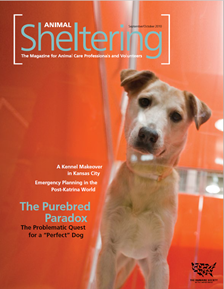Animal Sheltering 2010-12
SEPTEMBER / OCTOBER 2010
Articles
Coffee Break In your space, you told us about a time when you decided to stop working in the animal sheltering and rescue field, the reasons you wanted to leave—and what brought you back.
Collars and Sense It’s often said in the sheltering field that a collar and identification tag are a lost pet’s best chance of returning home. That’s especially true for felines: At a time when the homeless cat population is at crisis levels nationwide, only 2 to 5 percent of the millions entering shelters each year are reunited with their families. Shelters can help by modeling good cat identification practices to potential adopters.
All Roads Lead to Home Moved by the extremity of the pet overpopulation problem in their region, veterinary students at the Mississippi State University College of Veterinary Medicine launched the Homeward Bound Project, a transport program taking adoptable dogs from overcrowded shelters in the South to shelters in the Northeast, where there’s often greater demand for them.
The Purebred Paradox The quest to create the “perfect” dog may be contributing to a genetic health crisis among purebreds. A lack of genetic testing, mating of closely related animals, and breed standards that encourage extreme features over health have been blamed for a host of health problems facing scores of breeds today.
Emergency Planning After Katrina Thanks in part to the tragedy of Hurricane Katrina, the welfare of pets is now widely recognized as a critical aspect of any emergency preparedness plan. Animal shelters in nine jurisdictions in Northern Virginia have banded together to make sure that if a calamity ever strikes their region, pet owners and their furry best friends will be able to seek refuge together.
One Cool Tool The most common option for working with frightened dogs is the catch pole, the tool most ACOs and shelter staff resort to when a dog refuses to be handled. But the catch pole can be abused; as often as possible, shelter staff and ACOs should seek humane alternatives. One of these is the Y pole—a “Y”-shaped metal pole that functions as an extension of the human hand and, used properly, can help convince animals to relax.
Force for Good The major raids that result in the rescue of dogs from puppy mills begin not with dramatic stakeouts, but rather with a flurry of phone calls, e-mails, and paperwork. At The Humane Society of the United States, that hard work is the job of staff members on the Wilde Puppy Mill Task Force, part of the organization’s larger Stop Puppy Mills campaign. Task force members Justin Scally and Michelle Cascio discuss the challenges and successes of the group’s first year.
Canine Distemper Virus: Anatomy of an Outbreak Canine distemper virus can easily enter a shelter, is tricky to diagnose, and may wreak havoc on a shelter’s dog population. A veterinarian and a shelter official discuss the policies and procedures that helped a shelter in West Kennebunk, Maine, cope with an outbreak.
The Tracks of My Volunteers Shelters need systems to track information related to their volunteers—everything from names and emergency contacts to education and the hidden talents and community connections that can benefit the organization. Problem is, volunteer managers are usually so busy they either can’t take time to develop the tracking systems they need, or don’t take the time to put onto paper what they know in their heads. Setting up a system anyone can use will save time and help you get the most out of your volunteers.
Blankets and Beyond Eileen Smulson’s nonprofit, Operation Blankets of Love, helps provide many of the little extras—everything from blankets and towels to cat scratchers and dog igloos—that Los Angeles area animal shelters couldn’t otherwise afford.
Scoop

